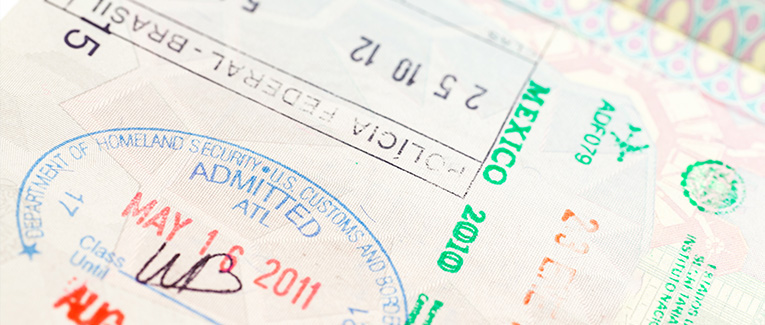
Many people in the U.S. who are on a nonimmigrant visa may either extend their status or change to a different nonimmigrant status. A nonimmigrant status may allow them to stay in the U.S. and/or legally work if they possess a work visa. However, if the current visa stamp in their passport is expired or is about to expire, they will need a new visa stamp before entering into the U.S. again. This also applies if they were to travel overseas. It is important to understand that a legal status and a visa stamp are two different things. See Visa Stamp vs. Authorized Stay Duration for more details.
A person on a nonimmigrant visa has two choices for visa stamping:
1. Go to a neighboring country like Canada or Mexico.
2. Go to their home country for visa stamping.
If they are eligible, many people prefer to go to Canada or Mexico because of their geographical proximity to the U.S.
U.S. Consulates in Mexico are located in the following cities:
– Ciudad Juarez
– Matamoros
– Nogales
– Nuevo Laredo
– Tijuana
All of these U.S. Consulates are collectively referred to as border posts.
Please note that the visa stamping process in Mexico takes at least three days: one day for fingerprinting, another day for an interview, and a third day for passport pickup. However, it may take longer.
Eligibility
In general, Third Country Nationals (TCNs or non-Mexican nationals) who live in the U.S. may be eligible to renew their visas in Mexico if they are renewing within the same visa category (except for B-1, B-2, or H-2) and have never been out of status. You are eligible to get your visa stamped in Canada or Mexico if you have never been “Out of Status”. You can use the I-797 form, EAD card, I-94 form, pay stubs, etc. to prove your status. If you cannot prove that you are “In Status”—or if you actually were “Out of Status”—you need to go to your country of citizenship for visa stamping.
If you are changing from a non-F-1 status (i.e. B-1, H-4, J-1) to an H-1 status, you should consult an immigration attorney before going to Mexico for visa stamping.
If you are not a citizen of Mexico and are currently staying in the U.S., you can apply for a new visa in Mexico for the following visa types:
– Student
– Exchange visitor
– Journalist
– Religious
– Temporary worker (H, L, O, P)
– Crew
Additionally, the following categories of Third Country Nationals (TCNs) can apply for a U.S. visa in Mexico:
- Third Country Nationals who normally reside in a Visa Waiver Program (VWP) country and who have lost or had their biometric passport stolen may apply in Mexico for a tourist (B-1/B-2) or transit (C) visa in order to return to their home country.
- Third Country Nationals who normally reside in a non-Visa Waiver Program country and who have lost or had their visa stolen may apply in Mexico to renew their tourist (B-1/B-2) visa in order to return to their home country.
Ineligible
The following categories of Third Country Nationals cannot apply in Mexico:
- If you would like to get a visa stamped for a visitor, transit, diplomat, treaty trader, treaty investor, H-1A, H-2A, H-2B, or Q worker, you must apply for a visa in your home country if you are not a citizen of Mexico.
- A visa for crew is not available at Nuevo Laredo.
- If you have ever been “Out of Status” because you overstayed your visa or I-94.
- Third Country Nationals who are not residents of Mexico and who are applying for a B-1/B-2 visa (including B-1/B-2 renewals).
- Applicants who entered the U.S. with a visa issued in their home country and changed status with USCIS in the U.S. to seek a new visa in a different visa category.
- Applicants who entered the U.S. in one visa category and are seeking to reenter the U.S. in a different visa category.
- Applicants who entered the U.S. under the Visa Waiver Program.
- Applicants who obtained their current visa in a country other than that of their legal residence.
- Applicants who were informed when they obtained the original visa in their home country that they are subject to National Security Entry Exit Registrations (NSEERs)
- Citizens of North Korea, Cuba, Syria, Sudan or Iran.
Risks
Such applicants may encounter difficulties at the time of the interview when they apply for a visa outside of their home district. Many times, the visa may be denied because the consular officer may not be familiar with the documents in the applicant’s home country, or they believe that fraud indicators are present in the applicant’s file.
Applicants will only be able to reenter the United States if they are found eligible for a new visa and actually have the visa stamped in their passport. I-94 forms (even if valid), accompanied by previously expired visas, will no longer be valid for the automatic reentry of persons traveling from Canada or Mexico if during their visit they applied for a new visa that has not, in fact, been issued.
Additionally, if your application requires additional administrative processing, you may not be able to reenter the U.S. until such processing is complete. You must keep that in mind before you decide to go for visa stamping in Canada or Mexico.

